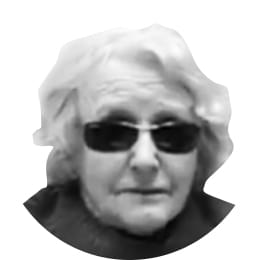Cataract
What is cataract?
Cataract, also known as stern curtain, is clouding of the natural human lens within the eye. It may be characterized by slight to full opacity and obstruction of the passage of light through it. Another popular name of the disease is "lens clouding". The word cataract itself derives from ancient Greek with the meaning waterfall. It most commonly affects older people. The cataract usually progresses slowly, but can lead to loss of vision if it is not treated. The condition usually affects both eyes, as almost always one of the eyes is affected earlier than the other. The causes for cataract development are unknown but there are risk factors like ultraviolet light exposure, diabetes, trauma, high degree myopia, chronic inflammation, etc. Age-related cataract is responsible for 51% of blindness worldwide, which is about 20 million people, according to the World Health Organization (WHO).
Cataract symptoms
Cataract in elderly patients develops slowly and painlessly. After the age of 60 slight lens clouding is common, but this process is normal and should not cause vision problems. After the age of 70 - 75, most people have a cataract that affects their eyesight. The main symptom is gradual decrease of vision. The most common symptoms in cataract are:
- blurry and cloudy vision
- double vision
- loss of color saturation
- vision problems when the colors have close shades
- seeing haloes around lights
- sensitivity to glare

Treatment of cataract
Unfortunately, today there are no medications – drops, pills or injections, which can cure cataract disease. If loss of vision interferes with your day-to-day activities, surgery may be considered. Today, removing cataract is a routine operation, and vision recovery is, in most cases, very fast. The operation is mild and involves replacing the patient’s cloudy lens with an artificial intraocular lens.
Eye Hospital Luxor, Plovdiv, has extensive experience in the treatment of cataracts. Dozens of patients with such symptoms are examined and/ or treated every week at the hospital, and Dr. Taskov is the first Bulgarian ophthalmologist to perform live cataract surgery using the phacoemulsification method in front of his colleagues from all over the world.
Laser cataract treatment
Following the latest developments in ophthalmic surgery, Eye Hospital Luxor can offer its patients surgical removal of cataract using the state-of-the-art laser equipment – femtosecond laser LenSx Laser System, produced by the world leader in ophthalmology – Alcon.
Learn moreWhy intraocular lenses are implanted in treatment of cataract
After the surgical removal of the cloudy human lens, it is necessary to place an artificial transparent lens in its place. If a new intraocular lens is not implanted and the required diopter is not compensated for a clear focus on the retina, the patient will not be able to see.
Learn moreFrequently asked questions
Before any medical procedure, the patients and their family have many questions. Most people worry about possible risks, while others are interested in how long the recovery period is expected to be. You are welcome to discuss your concerns with our specialists at Eye Hospital Luxor, but in the meantime you can find answers to your questions in this section.
What is cataract?
Cataract is clouding of the natural human lens, which is inside the eye just behind the pupil.
Is cataract a condition affecting only elderly people?
Most often cataract develops slowly over time and affects people over 50 years of age. Approximately half the people develop cataracts at the age of 65, and almost everybody over 75 years of age have at least some initial form of cataracts in one or both eyes.
In very rare cases congenital cataracts are observed in children. They are usually associated with an infectious disease during pregnancy, but can also be hereditary.
My doctor diagnosed me with cataract, but recommends that I should wait some time before I have surgery. Why?
Early cataracts often cause very little or almost no impairment of the vision. Your doctor will most likely observe your cataract until he is convinced that its progress will significantly affect your day-to-day activities. Then he will recommend surgical treatment
Is cataract surgery a serious thing?
Every surgical procedure involves some risk, so cataract surgery is a serious thing. However, surgical removal of cataracts is the most common operation in the world. Many ophthalmologists have already performed thousands of surgeries and therefore have extensive experience. Our recommendation is to choose an experienced surgeon, which would significantly reduce the risk of unwanted complications.
How is cataract removed?
A small incision (about 2 mm) is made on the front surface of the eye using a special blade or laser. Then a circular hole is cut into the frontal part of a fine membrane (front capsule) that envelops the natural human lens. The lens is crushed into pieces by a laser or ultrasound, so it can easily be removed from the eye.
After the natural human lens is removed, it is replaced by a transparent implant called intraocular lens, to restore the vision. In most cases, the eye quickly recovers from this seamless surgery.
Today some steps in the cataract surgery can be performed with a computer-controlled laser system (femto-laser), instead with tools held by the surgeon.
What is secondary cataract?
In a small number of cases, months or years after cataract surgery, the posterior part of the lens capsule, which remains in the eye for greater safety, becomes cloudy and causes blurred vision again.
This secondary cataract can easily be cured by a much less invasive procedure called YAG-laser capsulotomy. In most cases, 15 minutes after the procedure the vision returns.
My grandfather had surgery a long time and had to wear thick glasses afterwards. Is this still necessary?
It is very rarely nowadays that some patients may have to wear thick glasses after a cataract surgery. With the modern methods of cataract surgery, the cloudy natural human lens is replaced with a transparent artificial intraocular lens, which most often also corrects the far-distance vision eliminating the need of wearing glasses for far distance.
In fact, the high-tech multifocal intraocular lenses can even eliminate the need of wearing reading glasses after surgery. During the medical examination, you may ask your doctor for the possibility of being independent of glasses.
How much does the cataract surgery cost?
For Bulgarian citizens with health insurance, the cataract surgery is covered by the National Health Insurance Fund. The patients have pay the artificial intraocular lens they have chosen. More information about the types of intraocular lenses can be found here.
Today some steps in the cataract surgery can be performed with a computer-controlled laser system (femto-laser), instead with tools held by the surgeon. The use of this computer system involves additional materials and consumables, which have to be paid by the patients.
What are the possible side effects from cataract surgery?
As with any other surgery, pain, infection, swelling and bleeding are possible, however, the patients rarely experience serious complications after surgery. In most cases, the complications or side effects of the procedure can be successfully cured with medication or another medical intervention.
In order to reduce the risk of possible problems after surgery, follow your surgeon's instructions and the postoperative regimen and immediately report any unusual symptoms.
Are there different cataract surgeries?
Yes, there are different types of cataract surgery. The surgical technique used by the ophthalmologist depends on many factors, including the individual characteristics of the eye for surgery, the surgical equipment, and surgeon’s experience.
In developed and developing countries, the most commonly performed cataract surgery is called "phacoemulsification" (shortly "phaco") with implantation of a soft intraocular lens.
This type of procedure allows the work to be done through a very small hole without stitching at the end of the operation. Through a set of fine instruments, the cataract is reached, then it is broken into pieces with ultrasound energy and removed from the eye with aspiration(suction).
Using a special injector, the soft intraocular lens is inserted into the eye, then it is unfolded in it. The surgeon adjusts the artificial lens in the right position – at the same place as the natural human lens (just behind the iris).
The laser assisted cataract surgery (also called laser cataract surgery) is a modern variation of the standard phaco-cataract surgery.
In laser cataract surgery, important steps in the surgery that are traditionally performed by instruments in the surgeon's hand, are now done through a computer-controlled laser system of super precision. These steps include: making incisions in the eye, creating an opening in the anterior capsule of the lens to access the cataract, breaking the cloudy lens before removing it from the eye.
During your consultation and preoperative tests, ask your treating physician about the types of cataract surgery and which operating equipment is best suited to you.
Is the patient awake during cataract surgery?
Yes, the patients are usually awake during cataract surgery. This avoids the risks of general anesthesia and allows the surgeon to communicate with you during the procedure.
If the thought of being awake during the surgery bothers you, don’t be afraid! Before the intervention you will be given a pill that will completely relax you and you will not feel any discomfort.
It is very likely that you will be injected an intravenous medication that will make you feel relaxed and comfortable during the procedure.
Despite the relatively rapid recovery from the anesthesia, you cannot drive after the cataract surgery and you must have somebody with you to take you home.
Can cataract surgery be performed in both eyes simultaneously?
If you have cataract in both eyes, one eye is usually operated first, and after about a month surgery is performed on the other eye. This approach allows the first eye to recover before the operation of the second eye.
Modern cataract surgery is extremely safe and effective, and the rate of complications is very low. For this reason many surgeons offer cataract surgery on both eyes on the same day. This practice is supported by the significant percentage of cataract surgery performed this way in some European countries, with excellent visual results and without increase of the complications rate.
The main advantages of surgery on the same day are the need for fewer postoperative follow-up examinations, faster recovery of the vision of both eyes, which is important for driving and other daily activities, as well as a faster return to the normal rhythm of life.
The simultaneous cataract surgery may be appropriate in patients with high diopters for nearsightedness and farsightedness. Such patients are sometimes are unhappy when the cataract surgery is performed on different days, because they experience a visual imbalance during the waiting period. Then they do not wear their dioptric glasses and they can only see with the operated eye, while the other is excluded from the act of seeing – until the second eye is operated, the sense of spatial depth is impaired.
The main reason for performing simultaneous cataract surgery is the implementation of high-tech multifocal intraocular lenses, which allows faster brain adaptation to the new way of seeing. Surgery on the same day is recommended for people with impaired mobility, when each visit to a hospital is associated with significant difficulties for them and their relatives.
Can a cataract surgery be performed on the same eye more than one time?
The cataract surgery cannot be reversed, because after the removal of the cloudy natural lens during the procedure it cannot be put back.
If there is a problem with the intraocular lens used during surgery or if there is another complication, some aspects of the surgery may be readjusted or repeated. This includes adjusting the intraocular lens or replacement with a different lens.
The cataract surgery is one of the safest and most often performed surgical interventions worldwide. The need for revision after cataract surgery is extremely rare.
Can the cataract surgery treat astigmatism?
There are several ways to correct astigmatism during cataract surgery.
One option is to replace a cloudy human lens with a high-tech intraocular lens called a toric IOL. This lens has additional diopter at a certain degree that compensates for corneal astigmatism and provides much more accurate focusing of light on the retina.
For better precision, when implanting toric lenses, many surgeons use the so-called digital marker. With the systems for computer visualization, such as Callisto or Verion, the exact position of the toric intraocular lens is projected into the eyepieces of the operating microscope. In this way, the ophthalmologists see a reference image of the ideal lens position during the whole procedure and can position it with extreme precision.
Another option for correcting astigmatism during cataract surgery is through a surgical technique called limbal relaxing incisions. It consists of two opposed peripheral corneal incisions. This technique can treat only small diopters of astigmatism, with relatively low predictability of the result.
If the astigmatism appears as a problem after cataract surgery, laser vision correction can be performed at the second stage after the final postoperative recovery.
Does the cataract cause blindness?
Yes, if it not surgically treated. Cataract causes a gradual decrease in vision, which in practice leads to blindness.
When people hear the word blindness, they assume that this condition is permanent and cannot be cured. In the cases of blindness resulting from cataract, the vision most often can be recovered by cataract surgery and implantation of intraocular lens.
The results of the modern cataract surgery are so good that practically blind, before the surgery patients, can see so well after the recovery from the surgery that they can even drive a car without glasses. However, in order to have the best visual result after cataract surgery, it is not recommended to delay the surgical procedure until the vision is severely impaired or the patient is practically blind. Advanced cataracts, causing severe vision impairment, are more difficult for surgery and are associated with an increased risk of complications.
Can the cataract surgery cure lazy eye?
Lazy eye, or amblyopia, is impairment in the development of the eyes, where the eye does not have normal visual acuity, even with glasses or contact lenses, despite the absence of established disease or trauma.
Amblyopia typically begins in early childhood and most often affects one of the eyes, but in some cases it may affect both eyes. The most common cause of lazy eye is the abnormal position of the eyes, called crossed-eye or strabismus. This difference in position does not allow the two eyes to be used equally.
Congenital cataract can cause amblyopia. The cataract surgery of young children in these cases can often completely correct amblyopia, or at least significantly improve the eyesight of the affected eye.
In elderly people with amblyopia, cataract surgery is unlikely to fully restore the vision of the lazy eye. However, it is possible for the patient to experience a significant improvement compared to the preoperative condition - depending on whether the vision is reduced mainly due to amblyopia or cataract.
Can eye drops prevent or treat cataract?
If such droplets are invented and distributed at a normal price, it would have a huge social effect on millions of people around the world – especially in the developing countries where access to operative cataract treatment is limited.
Scientists are working on the development of drops that could not prevent and possibly cure some cataracts. But even if they find the right components, many studies would have to be performed in order to assess the safety and the effectiveness of such drops in humans, and whether such drops can prevent the development of cataracts in aging eyes. It is also not clear whether the transparency of the human lens achieved through these drops will result in a similar visual result after a cataract surgery.
Currently, cataract is treated only with surgery with implantation of artificial intraocular lens.
Can cataract surgery be performed after laser vision correction?
Yes, cataract surgery can be done after laser vision correction (PRK, LASEK, Epi-LASIK, LASIK, Femto-LASIK).
The laser vision correction modifies the curvature of the anterior surface of the eye (the cornea). So when you visit your doctor, it will be helpful to carry all the medical records, especially those before the laser procedure.
Cataract surgery can be performed successfully without information about your previous condition. But it could direct your doctor to choose the most suitable intraocular lens for optimal visual result after the surgery.
Can I have cataract surgery if I have glaucoma?
Yes, you may have cataract surgery if you have glaucoma.
In some cases, cataract surgery can lower the intraocular pressure, thus reducing the number of medications you need to treat glaucoma, and even to completely eliminate the need of drops.
It is also possible to perform minimally invasive glaucoma surgery at the same time as the cataract surgery, and to treat both conditions in one time.
Patients with glaucoma may experience transient increases or decreases in the intraocular pressure after cataract surgery, and it is of upmost importance to follow the instructions of the doctor for applying the glaucoma drops before and after surgery, and to attend all follow-ups.
Cataract treatment: Is surgery the only option?
Currently and in the foreseeable future, cataract surgery is the only treatment for cataracts.
Although there is some evidence that a healthy diet can prevent cataracts, changing the dietary regimen or the lifestyle will not reverse the existing cataract.
Scientists are working on creating drops to prevent or cure cataracts, but these studies are at a very early stage. It is impossible to predict when and whether such drops will be created at all, and whether they will be as effective as cataract surgery.
In addition, vision recovery after cataract can correct nearsightedness, farsightedness and astigmatism with the implantation of intraocular lenses, after cataract removal.
This means that in addition to vision recovery, modern cataract surgery can reduce the need for glasses after surgery.
There are even multifocal intraocular lenses, which can correct the normal age-related reduction in the near vision (presbyopia), and therefore reduce the need for reading glasses.
Cataract surgery does not generally cause a "dry eye".
Cataract surgery does not generally cause a "dry eye".
Only two small incisions are made in the cornea during the procedure. They heal very quickly after the surgery, without need of stitches, and have no significant effect on the production of tears from the eye.
Although cataract surgery does not cause "dry eye", existing “dry eye” before cataract surgery may affect the postoperative outcome.
Does the cataract surgery treat "floaters"?
Cataract surgery restores the vision, which has been reduced due to the clouding of the natural human lens, located just behind the pupil.
The so-called "floaters" are located in the posterior segment of the eye - in the vitreous body, which fills a large cavity in the eye between the lens and the retina. Therefore, the removal of a cataract (cloudy human lens) with subsequent implantation of a transparent intraocular lens, cannot reduce the presence of floaters in the vitreous body.
In fact, if you see "floaters", after a cataract surgery, they can become slightly more tangible – the reason for this is the increased postoperative clarity of the vision.
The floaters are relatively common. In most cases, they are very small in size and can only be seen under certain light conditions. In principle, they are not dangerous and no treatment is needed.
The floaters are relatively common. In most cases, they are very small in size and can only be seen under certain light conditions. In principle, they are not dangerous and no treatment is needed.
Is cataract surgery painful?
There is very little or no discomfort during the cataract surgery.
You will be awake during the procedure but measures will be taken before and during surgery to avoid pain.
In fact, it is very likely that you will almost have no recollection of the cataract surgery,although you will not be under general anesthesia, as in large surgery interventions.
On the day of surgery you will be given a pill to help you stay calm and relax. With the use of anesthetic drops, any unpleasant sensations in the eye will be numbed and disappear. By dropping anesthetic will dull and disappear the unpleasant sensations in the eye. In some cases, an intravenous medication may be added during surgery, in order to make sure you feel comfortable. The operator may ask you how you feel during the procedure and if you have any discomfort to add anesthesia.
What will happen if I don't have cataract surgery?
In most of the cases, the cataract will progress over time, causing a progressive reduction in vision. Driving can be dangerous and generally the quality of life will be reduced.
Many people are practically blind because of untreated cataracts, and cataracts can cause total blindness after a long period of time.
It is impossible to determine how fast the cataract will progress. If you find that your eyesight gets worse before the next appointed medical exam – seek your doctor sooner, check your vision and eyes.
Untreated cataracts may "overripe" – a condition where surgery becomes more difficult and increases the risk of complications.
It is recommended that cataracts are operated when problems with the vision start, not to delay it for months or years.
When to have cataract surgery?
When is the right time for cataract surgery? If you have visual impairments and have been told that you have a cataract, it is very likely that the cataract is advanced enough for surgery.
In some cases, people experience unpleasant visual problems such as glare or haloes at night, even before the ophthalmologist finds a significant clouding of the human lens in a pupil dilation exam. This condition, called dysfunctional lens syndrome, is often sufficient reason for many people to consider cataract surgery, especially if they need good night vision.
Will I need glasses after cataract surgery?
That depends.
If you choose a cataract surgery with a monofocal lens implant, you will most likely need glasses for reading, work with computer, or other specific near-distance activities, depending on your lifestyle.
With established corneal astigmatism, it is necessary to correct it with a toric lens. If you choose a standard intraocular lens without a toric component, you will wear glasses not only for close but also for far distance after surgery.
There are options in which the dependence on glasses can be completely eliminated – by implanting high-tech multifocal intraocular lenses that provide excellent results and allow many people to be independent of glasses.
Types of cataracts
Every clouding of the crystalline lens is defined as cataract. There are congenital and acquired cataracts:
Congenital cataracts
(hereditary or in an embryopathy – a result of mother’s disease)- Anterior and posterior polar
- Pyramidal
- Fusiform
- Lamellar (or zonular)
- Pulverulent
- Coronary
- Cerulean
- Posterior subcapsular
- Nuclear
- Cortical
- Total
- Membranous
Acquired cataracts
- Age-related
- Traumatic
- Radiant exposure
- Infrared
- Ionizing radiation
- Electric shock and lightning strike
- In systemic diseases
- In haemodialysis
- In diabetes mellitus
- Tetanic
- Cortisone
- In myotonic dystrophy
- In dermatological disorders
- Complicated (in other eye diseases)
According to the degree of maturity
- Incipient
- Intumescent
- Immature
- Mature
- Hypermature (it could become cataracta membranacea, lactea or Morgagniana)
According to the location of the opacities
- Nuclear
- Cortical
- Nucleocortical (predominantly nuclear opacities)
- Corticonuclear (predominantly cortical opacities)
- Posterior subcapsular
Our cataract patients
Eye Hospital Luxor combines modern interior, state-of-the-art technologies and specialists dedicated to their profession with many years of experience in various fields of ophthalmology, which with their high expertise and maximum fairness and responsibility improve their vision of their patients. More than 30,000 patients trust our professionalism every year.

Tatiana Kalcheva
"I am grateful to fate for bringing me together with Dr. Taskov."

Milena Petkova
"I am grateful to Dr. Taskov and to all the wonderful people for creating such a warm atmosphere."

Rosica Gencheva
"At Eye Hospital Luxor, every case is special."

Simeon Mechkarov
"If you want to see again I highly recommend Dr. Taskov's clinic."

Maria Doncheva
"I promise you that you will find help in Luxor. You will be pleased and you will be happy."

Stoyan Stoyanov
"Now I can see the beautiful birds in the sky. I can shoot with shotgun and aim quite well."

Totka Tyanova
"I am very happy with my choice of attending physicians, let there be more like them in Bulgaria!"

Radko Tyanov
"If you want to be cured, you should visit Eye Hospital Luxor!"

Ivan Gioshev
"My vision is crystal clear and I cannot believe that this is happening to me."

Hristina Vlasakieva
"I thank to all doctors in Luxor and I am going home very grateful."


John and Angela Simpkins
"I had 80% of my vision recovered after the first week following the surgery. After the second, my vision was 100% recovered."

Rosica Gencheva
"I came across very good specialists, I am very pleased."

Stoyanka Todorova
"My neighbor recommended me the hospital of Dr. Taskov. I have no words to describe how happy I am!"

Hristo Hristozov
"I realize that after the surgery my vision is getting better every day!"

Sabka Stoyanova
"The result is indeed magnificent. I cannot believe that I am seeing even the tiniest details."